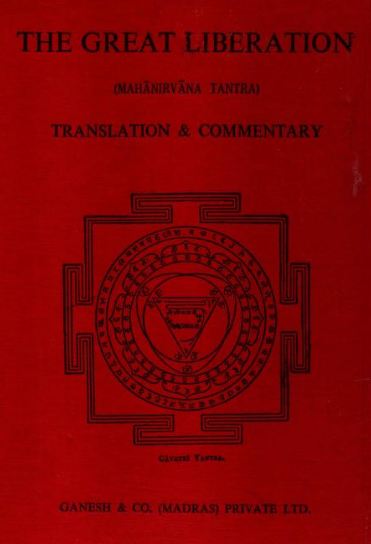‘Maha Nirvana Tantra’ PDF Quick download link is given at the bottom of this article. You can see the PDF demo, size of the PDF, page numbers, and direct download Free PDF of ‘The Great Liberation’ using the download button.
The Great Liberation PDF Free Download

THE LIBERATION OF BEINGS
THE enchanting summit of the Lord of Mountains,’ resplendent with all its various jewels, olad with many a tree and many a creeper,
melodious with the song of many a bird, scented with the fragrance of all the season’s flowers, most beautiful, fanned by soft,
cool, and perfumed breezes, shadowed by the still shade of stately trees; where cool groves resound with the sweet-voiced songs of troops of
‘Bharati says that Sadashiva of limitless power (Ameyashakti) after having framed the Six Amnayas (see Woodroffe’s “Shakti and Shakta “) was moved by the Mother,
the Adishakti, to reveal this Tantra which is mighty and the Bridge across the Ocean of Kula (Kulavärirashi).
When the Kali age, the uprooter of all acts of merit and the instigator of endless hateful sins, commenced then Parvati,
the Mother became anxious for the salvation of men who are averse to meditation upon the Supreme (Paramatma) and other religious practices and on the other hand, are addicted to sinful acts.
She, therefore, questioned Shiva who abides on Mount Kailasa concerning the means whereby they may be saved.
Mount Kailasa, the Paradise of Shiva. Esoterically, the Sahas rara Padma (see Tripura-sära, cited in Bhaskararaya’s Commentary on Lalita sahasra-name, v. 17).
The Kulárnava says that there is Kailasa where His worshippers are gathered. The first few lines on this page are somewhat freely rendered.
Literally covered by the shadows of great trees, the shadows of which are motionless: that is, the trees are so great and so close to one another that there is perpetual shade.
Apsara, and in the forest depths flooks of Kokila maddened with passion sing; where (Spring) Lord of the Seasons with his followers ever abides-(the Lord of Mountains,
(Kailasa); peopled by troops of Siddha,’ Charana, Gandharva, and Ganapatya (1-5). It was there that Parvati, finding Shiva,
Her gracious Lord, in mood serene, with obeisance bent low and for the benefit of all the worlds questioned Him, the Silent Deva,” Lord of all things movable and immovable,” the ever Beneficent” and ever.
GUNA
It cannot be said that current explanations give a clear understanding of this subject. Yet such is necessary, both as affording one of the chief keys to Indian philosophy and to the principles which govern Sadhana. The term guna is generally translated “quality,” a word which is only accepted for default of a better. For it must not be overlooked that the three guna (Sattva, rajas, and tamas), which are of Prakriti, constitute Her very substance. This being so, all Nature which issues from Her, the Maha-karana-svarupa., is called trigunatmaka, and is composed of the same guna in different states of relation to one another. The functions of sattva, rajas, and tamas are to reveal, to make active, and to
suppress respectively. Rajas is the dynamic, as sattva and tamas are static principles.
That is to say, sattva and tamas can neither reveal nor suppress without being first rendered active by rajas. These gunas work by mutual suppression.
The unrevealed Prakriti (avyakta-prakriti) or Devi is the state of stable equilibrium of these three guna.
When this state is disturbed the manifested universe appears, in every object of which one or other of the three guna is in the ascendant.
Thus in Devas, as in those who approach the divya state, sattva predominates, and rajas and tamas are very
much reduced.
That is, their independent manifestation is reduced.
They are in one sense still there, for where rajas is not independently active it is operating on sattva to suppress tamas, which appears or disappears to the extent to which it is, or is not, subject to suppression by the revealing principle.
In the ordinary human jiva, considered as a class, tamas is less reduced than in the case of the Deva, but very much reduced when comparison is made with the animal jiva.
Rajas has great independent activity, and sattva is also considerably active. In the animal creation sattva has considerably less activity.
| Author | Arthur Avalon |
| Language | English |
| No. of Pages | 481 |
| PDF Size | 227.5 MB |
| Category | Astrology |
Mahanirvana Tantra- The Great Liberation Book PDF Free Download
